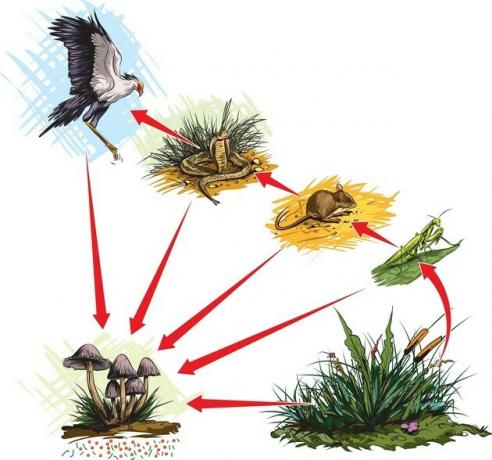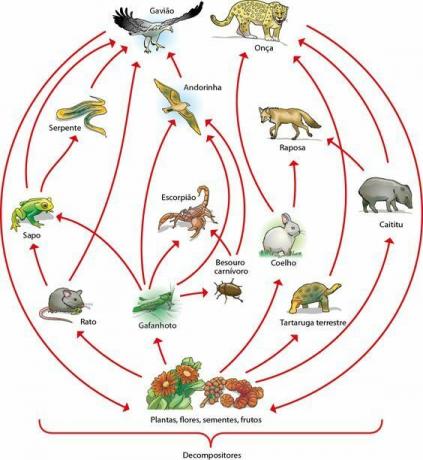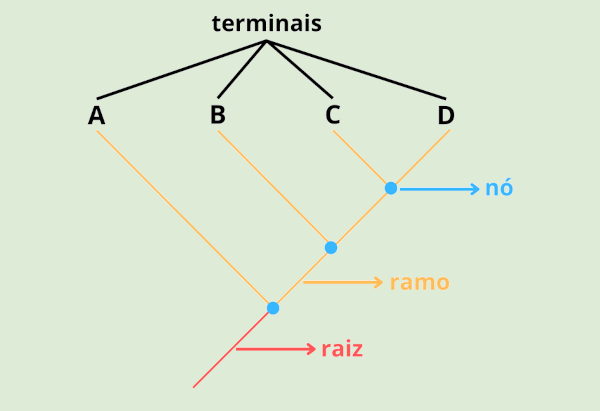The food chain is all matter and energy exchanged between living beings. The food web is the union of several food chains in a network.
To understand the difference, it's important to know the classifications within a chain and how the life cycle works.
| Food chain | food web | |
|---|---|---|
| Definition | The cycle of energy and matter exchanged between living things through their feeding relationships. | Several food chains interconnected with each other. This is because the same living being can be part of more than one food chain. |
| how to organize | The food chain is linear and unidirectional, being based on trophic levels (producers, consumers and decomposers). |
The food web is non-linear, formed by several different food chains, since animals can be part of countless chains. |
| Levels |
The three groups of a chain classify the trophic levels.
|
There are no properly defined levels for a food web. To exemplify, we cite the classifications of consumer beings:
Human beings move between these definitions, as they feed on everything and affect various chains on the planet, forming part of a gigantic food web. |
What is the food chain?
Living beings form a feeding network among themselves. Composed of three groups (producers, consumers and decomposers), the food chain is formed by the set of living beings in which one serves as food for the other.
In this sense, these living beings transfer matter and energy through nutrition. The three groups of a food chain classify the trophic levels, which is the flow of energy transferred from one living being to another.

To better understand these levels, let's see about each of the groups:
Producers
It is the first level of the food chain, with plants and plankton being the biggest examples. This is because they are beings autotrophs, that is, they produce their own food through photosynthesis or chemosynthesis.
consumers
These are living beings that need to feed on others to obtain the energy and nutrients they need. These beings are called heterotrophs.
Consuming beings are further divided into three categories. These are:
- primary: herbivorous or omnivorous beings that consume those that produce their own food, that is, plants or plankton. The cow is an animal classified as a primary consumer.
- secondary: carnivorous or omnivorous beings that feed on primaries. The cat is an example.
- Tertiary: living beings that take energy and necessary nutrients from secondary consumers. We can cite the lion as an example.
Human beings transit between positions, since they can feed on both primary and secondary beings.
Decomposers
Present at all levels of the food chain, decomposers are responsible for the decomposition of organic matter. Thus, they produce energy and capture the nutrients they need, and then return to the environment what is essential for the cycle to start again.
Among the examples of decomposers, we can mention bacteria and fungi, which are present in almost all ecosystems on Earth.
Food chain examples
Human
Humans are omnivores and eat both plants and meat. Therefore, they can be primary or secondary consumers. This is because the human being can feed on the cow, for example, which feeds only on plants and is a primary consumer.
Terrestrial
Plants, producers, serve as food for primary consumers (insects and other herbivores and omnivores). Then these animals serve as food for larger animals, fostering the entire cycle of life on land.
aquatic
Not unlike the terrestrial chain, phytoplankton are the largest producers at the aquatic level. They are microscopic creatures that carry out photosynthesis, like small algae, which serve as food for zooplankton. These, in turn, feed larger animals, thus forming the cycle of life in water.
What is the food web?
The food web, or food web, is the collection of interconnected food chains. In this sense, the food web is a representation of the connection between the many existing food chains.
The same animal can belong to different food chains, which are part of a larger ecosystem. In the food chain, there is the idea of a cycle, but the food web is the union of these cycles in a large network.

Therefore, a food web shows us that the trophic relationships between living beings are very complex. The food chain reveals only one aspect of the exchange of matter and energy between ecosystems, the web integrates all of this into a single network.
Human beings, for example, are part of a gigantic food web, as they can move between levels of consumers, depending on the need.
See also the difference between:
- Wild animals and domestic animals
- ecosystem and biome
- Camouflage and mimicry
- crocodile and alligator

